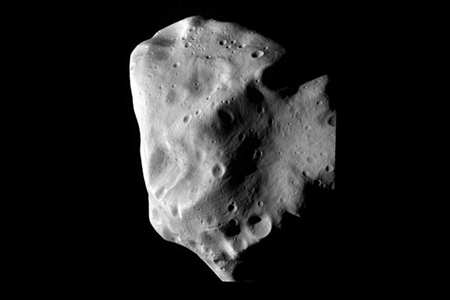The Asteroid Lutetia Is Floating Reminder Of Our Solar System’s Birth.
The asteroid Lutetia is a “primitive body”, which means that the son of a bitch was around at the formation of our solar system. Lutetia is currently single, and despite her advanced age is still looking for love.
io9:
The asteroid Lutetia is the best — and possibly only — example we’ve got of what’s known as a primitive body, which means it dates right back to the birth of the solar system. All other objects in the asteroid belt appear to be fragments of larger bodies that broke apart eons ago. Lutetia has remained a more or less contiguous body for the last 3.6 billion years, and the latest evidence suggests it once tried to form a molten iron core just like an actual planet.
Admittedly, Lutetia has changed a bit in the last few billion years, as countless impact events have knocked entire chunks off the asteroid, transforming what was probably once a spherical body into the misshapen rock we see today. There are boulders about half the size of Australia’s Ayers Rock strewn all over the surface. This debris is about 50 to 80 million years old, practically nothing compared to the 3.6 billion year old interior.
Indeed, it’s what going on underneath that’s of particular interest to astronomers, and the European Space Agency’s Rosetta probe and its VIRTIS spectrometer were able to get the best readings yet during a recent flyby. The data suggests the mass of Lutetia is about 1.7 million metric tons. That’s a bit less than expected, but still easily enough to make it one of the densest asteroids in the solar system.
The ESA explains what that means:
The density implies that Lutetia contains significant quantities of iron, but not necessarily in a fully formed core. To form an iron core, Lutetia would have had to melt as a result of heat released by radioactive isotopes in its rocks. The dense iron would then sink to the centre and the rocky material would float to the top.
However, VIRTIS indicates that Lutetia’s surface composition remains entirely primordial, displaying none of the rocky material expected to form during such a molten phase. The only explanation appears to be that Lutetia was subjected to some internal heating early in its history but did not melt completely and so did not end up with a well-defined iron core.
Rosetta is already long gone from Lutetia, but there’s only so much we could have learned from a flyby anyway. There’s a lot more to be learned from placing a lander on the asteroid, which might be possible at some point in the next decade or so. As Rosetta project scientist Rita Schulz observes, this is one seriously intriguing asteroid:
“We picked a most important member of the asteroid belt. All the asteroids encountered so far were different from each other, but Lutetia is the only one in which both primordial and differentiation features have been found. These unexpected results clearly show that there is still much more to investigate before we understand the belt fully.”
C’est très magnifique!




